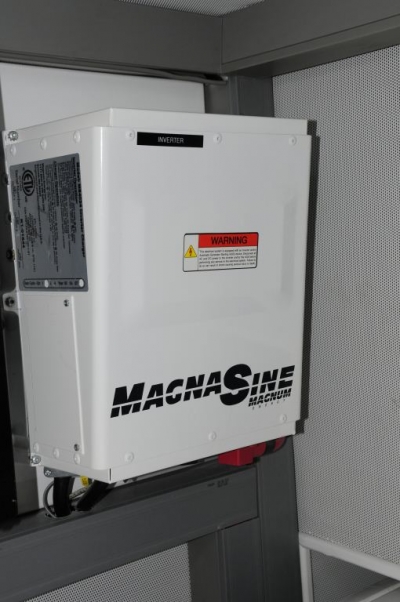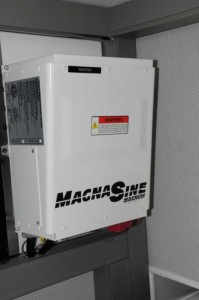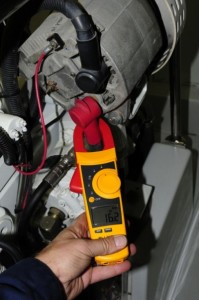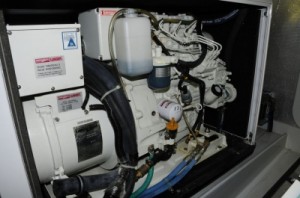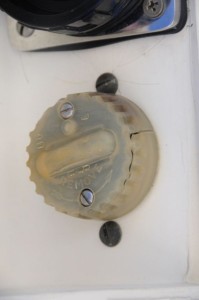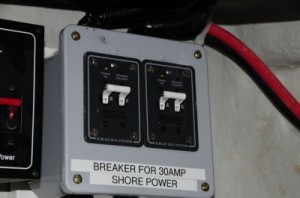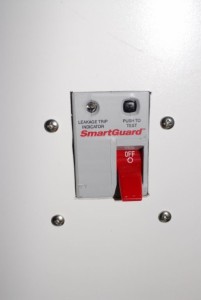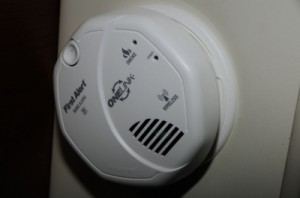Ask Steve: Electric Tea Kettles, Fire, and AC Electricity
By Steve D’Antonio
Photos by Steve D’Antonio
On boats with both a powerful inverter and a generator on board, the decision to start the generator should depend on the load and the length of time it will run.
Hello Steve,
I hope this note finds you well and hope that you are staying cool during this heat wave. I am actually writing for a friend, in trying to settle a…discussion lets say, between this lovely couple. They have a 47′ trawler.
The question, or subject of discussion, is whether or not it is necessary to run the generator when underway, if you use an electric tea kettle to boil water, and what could the consequences be.
On a recent trip from RI to Provincetown, MA, he realized that the generator battery was not being charged. He checked the alternator and it was fine, checked the usual things and all seemed ok. The next day, as they began their trip back to RI, he noticed now that the house batteries were not charging, the voltage kept dropping and eventually they lost all power from the batteries. Note that they just installed new batteries a month ago.
He thinks that this could have been caused by his wife by often using the electric tea kettle while underway, without running the generator. She thinks…..not.
I told my good friend that the only person who could answer this would be you. So here I am trying to help a friend (I think and hope…)
So, what is your opinion Steve?
Love to hear your thoughts.
By the way, I thoroughly enjoyed your latest article on your blog regarding faulty electric cords and the danger associated at marinas. Never thought of it.
Thank you for all your professional and useful insight and for making us all safer boaters. See you at TrawlerFest in Baltimore. We will be in the Chesapeake for the Krogen rendezvous and will surely attend Trawler Fest.
Thank you for your time.
Sincerely,
Roberto
Roberto,
You didn’t share any information regarding battery bank capacity, inverter or alternator size. However, generally speaking, the inverter is supplying power to galley and other receptacles. At rest, it’s power is derived from a house battery bank, from which it converts 12- or 24-volts DC to 120-volts AC. Using this approach the inverter can supply energy as long as the battery capacity will allow. While underway, provided alternators are sufficiently sized, and I suspect they are, for periodic high loads, one or both of them supplies the battery bank with charge current, which is then sent on to the inverter, with the battery bank acting as a buffer. This is actually a very good arrangement which, if properly engineered, typically works quite well. Your electric tea kettle probably draws no more than 500 watts, which is equivalent to about 35 amps, at 12 (actually 14.2) volts DC, from your battery bank and alternator; a load with which it should periodically be able to keep up. Provided the system is properly designed, this use is precisely what inverters are designed for.
This multimeter is indicating that the alternator is producing 16.2 amps, however, when when faced with a heavy load, from an inverter for instance, it’s capable of supplying significantly more, enough to keep up with a modest inverter load.
Running your genset to make a cup of tea is actually a hypothetical scenario I use in an argument against just such a practice. It’s tantamount to threading the proverbial needle with a sledge hammer and essentially unnecessary if you have an inverter package like the one described above. Using a genset in this manner is not only unnecessary, it’s wasteful. The efficiency when lightly loaded (500 watts compared to the genset’s 5000, 7000 or 10,000 output) like this is abominable and it’s less than ideal for the genset’s long term health. In short, the inverter is the way to go.
Now on to the battery charging failure. I suspect that’s unrelated or indirectly related to the inverter use, however, what’s curious is, if I understand correctly, the fact that the house batteries will not charge from either the engine alternators or the charger via the generator or shore power. What’s even more curious is the fact that the genset’s start battery is also affected. My guess would be there is a faulty connection or a blown fuse at the house bank, which is preventing it from accepting charge from any source. Why the genset is not charging its own battery remains unclear. Get a savvy, ABYC certified marine electrician aboard to carry out some troubleshooting, I suspect he or she will uncover the culprit very quickly.
Sincerely,
Steve
Steve
A very informative article (re: the July 15th blog, “Safe Shore Power and Electrocution Prevention”). I wonder if you should have mentioned if a Genset is running on a boat at a mooring or on an anchor could present some of the same AC problems. It is my understanding that gensets can cause the same electrocution hazards. Am I wrong?
Thanks for the articles,
Russ
Make no mistake about it, an AC generator can be an electrocution hazard with or without improper or damaged wiring, however, except in rare circumstances it is typically not a hazard to swimmers.
Russ,
This is an excellent question, I received several others very much like it.
When discussing electricity and faults, it’s important to remember that current, AC or DC, will return to its source, whether that’s a utility company, dockside transformer, generator, inverter or onboard isolation/polarization transformer. When a generator is the source of power, it has no reference to the water or earth ground and as such faults, rather than attempting to enter the water or the bottom, will typically return to the genset. To my knowledge, there has never been an in-water electrocution caused by a running genset aboard a vessel that was not plugged into shore power, ditto for inverters. Is it possible for someone to be electrocuted by a genset while in the water? I suppose I could come up with a scenario, if AC current was leaking into an ungrounded piece of hardware, like a trim tab or boarding ladder and someone touched it, while swimming, and then completed the path to ground by simultaneously touching something that was bonded, like a swim platform support. Or, under the same conditions, if someone entered the current path between these two pieces of hardware, they may be shocked or electrocuted. It’s possible, but again, unlikely.
However, that doesn’t mean you are off the hook electrically. The power produced by a generator or inverter is no less lethal than shore power. Therefore, a fault within a generator circuit can and has caused fatal electrocutions aboard vessels. Genset wiring must be fully ABYC compliant for, among other things, grounding and isolation between neutral and ground when the genset is not the source of power. Gensets and inverters benefit from ELCI circuit breaker protection as much as shore power, making this device a worthwhile addition to any AC electrical system.
Sincerely,
Steve
Steve,
Great article and quite timely. There is a 50M dollar lawsuit over a kid who died in a Traverse City Marina. It was posted no swimming, but the marina was aware of a problem. A tragedy that will take years to play out in court. A couple of questions that you might address in a blog:
1. Is there some sort of device that a marina can own that will test the water? Let’s say you drop a Rolex in and get a diver. It would be nice to test the water before he dives in!
2. Would European rules prevent all of this from happening? I am thinking about their use of RCD devices both on shore and the boats.
3. For our marina they are proposing some sort of $30,000 addition to the electrical cabinet that will protect several of our newer docks. Do you know anything about these? This is such an important topic. Thanks for addressing it.
Hope all is well,
Howard
Howard:
Thanks for the note and for posing these important questions.
“Testing” the water for AC fault current, while possible, is fraught with risk. I’ve known colleagues to make elaborate copper “paddles” that can be used to measure current in the water and its gradient. However, while it would be valuable to know if current is present, if the test determines no current is present, it’s no guarantee that the scenario will remain unchanged. For instance, cycling AC loads such as air conditioning and refrigeration systems may provide a deceptively false “all safe” reading using a water test set up, until they cycle on. The bottom line is, the only way to enter the water safely is if all AC current in the surrounding area is disabled.
European Union guidelines for boat building have mandated the use of residual current devices (the RCDs to which you refer which are now referred to as equipment leakage circuit interrupter or ELCIs) for their vessels for several years. I installed my first RCD a decade ago, aboard a vessel destined for a cruise in the Med. Here in the US, ABYC Guidelines have recommended (ABYC guidelines are voluntary for the most part) the use of ELCIs for all vessels using shore power for the past few years. Initially, there was a delay in providing the appropriate type of product, mass produced for boat builders, however, ELCI’s have been available for many years industrially and that’s what I typically sourced and used. In short, yes, an ELCI, which essentially is a GFI for your whole boat, would very likely prevent in water electrocutions in cases where the source of the fault current is a boat, rather than the dock. In the latter case, dock power could be protected by an ELCI and all receptacles must be GFCI protected. In the case of those who are electrocuted while swimming near a small, private dock, GFCI protection would very likely have saved their lives.
The marine “protection” device you are referring to is one with which I am familiar, I suspect it is this systemhttp://www.marinaguard.net/ . It essentially offers ground fault monitoring from a central location, and alerts operators to the problem.
The best and most effective way to avoid in water electrocution is to avoid swimming around shore power energized boats or docks. In the latter case, if it’s your own or a friend’s or family member’s dock and you chose to swim there, you should be absolutely certain, if that’s possible, all electrical power supplied to that dock is GFCI protected. Still, no electrical device is 100% reliable, swimming around an energized dock or boat, regardless of the presence of ELCIs or GFCIs is not without risk.
Sincerely,
Steve
These fuse holders were common on some makes of boats, but they don’t meet ABYC standards for over current protection of the incoming AC wiring because if the fuse were to blow, it wouldn’t trip both the hot and neutral lines simultaneously.
Hello Steve,
I attended one of your lectures at the Feb 2012 Trawlerfest in Ft. Lauderdale. I’m wondering if you can suggest how to replace one of my 30-amp fuse holders that supports the shore power connection. I have a 1987 38-ft Hershine, Newbury Port Trawler and both fuses disintegrated when connected to our latest marina stop. I was able to find a replacement fuse via NAPA, but the connection that powers up the air conditioner and heat didn’t fix the problem. When I checked the fuse holder, it had a crack in the metal band which a marine mechanic said probably is the culprit.
The problem is I haven’t any identification marks on the fuse holder to identify the manufacturer. I’m wondering if the picture attached showing the part will give you an idea where I can find a replacement. It’s possible that GB builders may be able to suggest a dealer, as we chartered a GB out of Sarasota a few years ago and I seem to remember a similar setup if this is still safe.
Gary
This professionally-installed AC-shore power circuit protection, installed within ten feet of the inlet, meets ABYC Standards. It is clearly labeled, installed in an approved enclosure, and indicates reverse polarity if the fault exists.
Gary:
The arrangement, and failure, you describe is not uncommon and even if you could obtain a replacement fuse holder, I wouldn’t go that route for a few reasons. First and foremost, using individual fuses to protect single phase, 30 amp, 120 volt shore power circuits is a violation of good electrical practices and ABYC guidelines, the latter clearly specify simultaneous trip circuit breakers for grounded and ungrounded conductors, i.e, neutral and hot. Individual fuses offer no such protection.
A preferable alternative, and one that will likely not cost much more, would be to install such a simultaneous trip, two-pole circuit breaker, in purpose made non-metallic enclosure, (in cabin, or in a lazarette or dry locker for instance), in the wiring between the shore power inlet and the electrical panel. This should be installed no more than ten feet from the shore inlet, the closer the better. You can abandon the legacy fuse holders in place or remove them and install blank covers or a louvered vent.
You can further improve on this installation by installing an ELCI breaker, making your vessel compliant with ABYC’s latest standards for circuit safety and electrocution protection. ELCI breakers behave like GFCI receptacle protection for your whole vessel. These of course cost more, however, I and many others in the industry believe they are worth the added expense. They are available from several manufacturers, including Blue Sea Systems,http://bluesea.com/products/3102100 .
Steve
Steve,
Per your suggestion, I’ll use a Blue Sea double-pole circuit breaker I have tracked to a Canadian dealer not far from my home. Will I need just the one unit to replace the two fuses that my boat has? I’m assuming this to be the case and I’ve talked to the local marina who originally said they wouldn’t do the connection, but after showing them the unit from the Blue Sea site, they agreed it would be a simple matter to make the connections required. I’m going to pick up the unit as well as the rear closure for the breaker and it will be installed where the old fuses were.
Any help you can provide would be greatly appreciated as we are currently cruising in the North Channel, and then heading south for the winter in Florida and Bahamas – we’re finally able to use our trawler for what it was meant to do.
Thanks,
Gary
Gary:
The folks carrying out the work must at least be well versed in ABYC guidelines, if not certified, regarding AC main breakers, E-11.17. They should be specifying or approving the hardware. And, while it’s not mandated, an ELCI breaker would offer you more protection.
An ELCI (Equipment Leakage Circuit Interrupter) provides an additional level of fault current protection aboard a vessel.
In short, for a 30-amp, 120-volt power supply, the main breaker, (preferred) ELCI or conventional, must be two-pole, meaning it has four connections on its back, two in and two out, switching the hot and neutral wires (and never the ground). Typically, this breaker has a single handle actuating both legs. Once installed, it must be fully enclosed. You should be able to neither see nor touch any connection. Wires should enter the bottom of the junction box rather than the top, to prevent water from entering.
Sincerely,
Steve
Linked fire alarms all sound if any of the alarms aboard detect smoke (and CO in some cases). These are especially useful when installed in locations where alarms may not be heard, such as engine rooms, thruster compartments and lazarettes.
Dear Steve,
I enjoyed your recent article on Electrical/Shore Power safety. I also want to suggest that you do an article on the merits and importance of fire/smoke detectors on pleasure boats with cabins (especially sleeping) . There was a fire in a Miami area marina in December of 2011 that destroyed 4 boats and started on a Marquis due to a faulty refrigerator (they think). The owners were on board and barely got off before the boat went down. Kidde has a new wireless smoke detector that we have installed in every space (total of 8) on our Marquis 65 and if one detector alarms, all sound the alarm. Great protection for personnel in sleeping quarters. Why the USCG does not require smoke detectors like they do CO detectors is beyond me. I would be interested in your thoughts.
Best regards,
Bud
Bud:
Thanks for the note and suggestion. Not only have I written several articles on smoke detectors for multiple magazines in both print and on-line editions, I was inspired to publish a special blog immediately after the fire you mentioned. And, I’m a fan of the wirelessly interconnected detectors; they work very well. These are available from First Alert – One Link in a combination smoke and CO version.
The blog is available in the SDMC blog archives and is entitled “Special Edition – Fire and Smoke Detectors”, published on January 3, 2012.
By the way, the USCG does not require CO detectors. ABYC guidelines, which are voluntary, call for installation of CO detectors on all gasoline powered vessels with enclosed accommodation spaces. My personal recommendation is that every vessel with an enclosed accommodation space, gasoline or diesel, be equipped with CO detectors in every sleeping area and the main saloon. There have been cases of folks being overcome from CO produced by another vessel.
Thanks as well for the follow up note you sent regarding the cause of the fire. For the sake of SDMC readers, the cause appears to be from faulty wiring in a Maytag refrigerator. There have been forty-one reported incidents. Affected unit model numbers are too extensive to provide here, however, they were sold between 2001 and 2004. More information can be obtained by visiting the Consumer Product Safety Commission website www.cpsc.gov or calling Maytag at 866-533-9817
Sincerely,
Steve
For more information on the services provided by Steve D’Antonio Marine Consulting, Inc. please e mail Steve at info@stevedmarineconsulting.com
or call 804-776-0981

